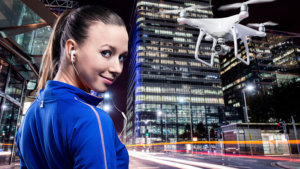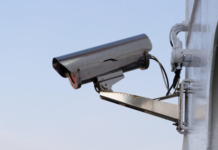
The use of drones by journalists is taking off, as more news organizations realize the value of an alternative data-gathering tool. But adoption is slow as reporters learn to navigate the regulatory complexities associated with the practice.
Matt Waite, a professor in the College of Journalism and Mass Communications at the University of Nebraska-Lincoln, first recognized the potential and value of drones while at a digital mapping conference several years ago. There, he came across a company that was building an aircraft with a camera on the bottom and a computer on board that was shooting pictures on the ground.
“I thought, ‘Wow, we could do mapping of hurricane damage on the spot, or in a matter of hours,’ ” recalls Waite. But the aircrafts costs $65,000 each and are illegal in the United States. There was no way to manually fly it as it was all automated.
“I was disappointed but I went back to my new faculty office and saw the FAA was looking to change regulations about UAVs,” he said. “I went to my deal and told him I thought we should start a drone lab and get out ahead of this because I knew there would be a lot of ethical and legal issues involved in this that was beyond a lot of journalism.”
So in November 2011, the university’s drone lab was born. After receiving some grant funding in 2012, the school did its first story partnering with another lab on campus covering the area’s worst drought since the Depression by flying over a dry river bed with a drone.
Eight months later, the school received a cease and desist letter from the FAA. After at least a year of going back and forth with the agency, it was determined that drones could be flown but only by a licensed manned aircraft pilot, and only in designated areas.
So Waite became a licensed pilot. The process made him realize that the greatest impediment to journalists using drones all along had been regulatory.
So to help others navigate the complicated process, Waite teamed up with Al Tompkins, the Poynter Institute’s senior faculty for broadcasting and online to hold the first Drone Boot Camp, or drone journalism school, last summer..
62 journalists attended with the intention of learning how to take an aeronautical knowledge test. Rules had changed so that one no longer had to be a licensed pilot to fly a drone.
As far as Waite knows, about 30 went on to pass the test.
“One reason we wanted to conduct these workshops is because we were seeing one-day training workshops that are too expensive for journalists. We want to put this knowledge within reach of every newsroom regardless of size,” said Tompkins. “Plus, journalists have unique training needs that are different from others who want to use drones in their work. Journalists will need specialized training around privacy concerns that drones raise in some people’s minds.”
The concept of using drones in journalism is still in its nascent stages, Waite acknowledged, but the potential for growth is big.
“I do think one day it will be commonplace,” he said. “And part of the argument is economics. Manned helicopter time runs at about $1800 per hour. A good drone high-quality camera costs about $1200 an hour to power the batteries up.”
Waite believes that the use of drones will be attractive to many news organizations considering that online video has become so important as a strategy.
“The use of drones provides unique video for your web site, and that’s highly valuable at a relatively low cost,” he said. “So pretty much any business that can generate high value at a low cost is going to do it.”
EARLY ADOPTER
CNN is an example of an early adopter of drone use in news reporting.
Greg Agvent, senior director of national news technology & CNN Aerial Imagery & Reporting, said CNN realized about two and a half to three years ago
“when many people were throwing stones at the FAA for integrating drones into the national airspace,” that it wanted to be part of the solution, not the problem.
CNN then did research with the Georgia Tech Research Institute and worked with the FAA to determine what role UAVs, also known as RPAs (remotely piloted aircrafts), could play in journalism.
“We took on a pretty serious role,” Agvent said. “We hold ourselves to a pretty high standard to begin with both in journalism and the technology we use. We wanted to be leaders in this space so we started very slow and did our due diligence. As a result, we became one of the leaders in the use of RPAs in journalism.”
Agvent is cognizant of the negative headlines that have been associated with drone-related activity.
So it has proceeded very, very carefully.
“We can’t afford to have the three letters CNN in front of the word drone in any of those headlines,” he said. “That’s not acceptable to us. Safety is not our goal. It’s a requirement. We have to act professionally and can’t do this in a haphazard way.”
In August of 2016, Agvent helped start up CNN’s own aerial unit and hired two small plane pilots – one of whom was a 20-year veteran of the CNN photojournalism school.
“When we first started, we were really still scratching the surface,” he said. “A drone is a tool. If you put it in the right creative person’s hands with the right technical person to execute, you can get some really interesting results.”
Drones, Agvent said, allow for more colorful storytelling as well. One of CNN’s editorial units wanted to do a story on a rock climber teaching recovering addicts outdoor skills in rural Colorado.
“We were able to tell the story in a way you’d never seen before,” he said. “Normally, we’d point the camera up but in this case the camera on the drone was working its way up as the climber was going up. We got some unique angles, and that added to the uniqueness of the story.”
In another case, a CNN crew was in Katmandu, Nepal, a couple of years after an earthquake had hit the region. They ran into a landslide and couldn’t get past it. A drone was launched a few miles up the river valley and found that several other villages were devastated. The crew took its findings to Nepalese authorities and were able to get humanitarian aid to those people.
“There’s no shortage of negative headlines about drones,” Agvent said. “A lot of it is related to fear. But there’s so much potential good for what these things can do. There are clear advantages to using them.”
By Mary Ann Azevedo
For more information visit: www.cisco.com


















